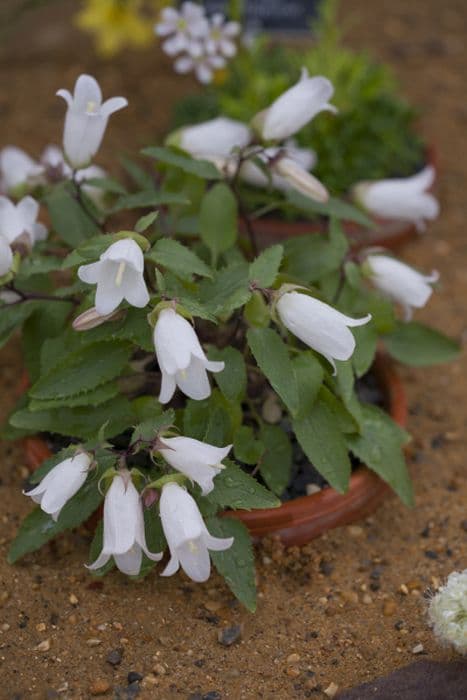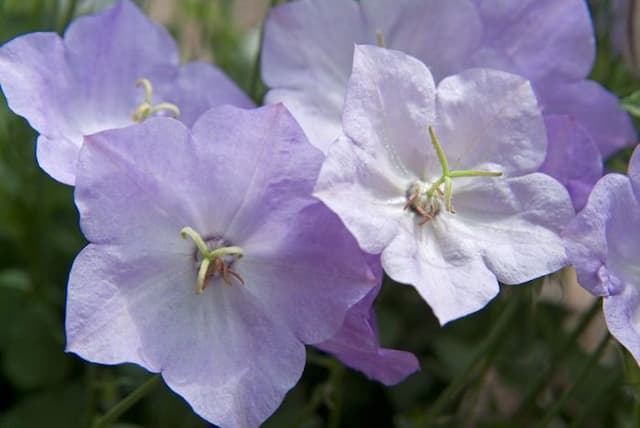Lobelia Lobelia Lobella Ocean Flash = 'Nulo042'

ABOUT
The Lobelia Lobella Ocean Flash, more commonly known as the Lobelia, is a striking plant characterized by its vivid floral display. The plant features a profusion of blooms that are notable for their intense color, which can range from a deep blue to a rich purple, sometimes even with a gradient or ombre effect giving the impression of the ocean's hues crashing into one another. Each individual flower is relatively small and tubular, with a slightly flared lip that opens to reveal the delicate inner petals and stamen. The foliage of the Lobelia Lobella Ocean Flash complements the flowers, typically being a lush green that may have a glossy or slightly matte finish. The leaves are generally lance-shaped, often with a slightly serrated edge, which adds texture to the plant's overall appearance. The leaves and the flowers together create a dense and bushy habit, which garners attention in garden displays and container plantings. Throughout the flowering season, the Lobelia Lobella Ocean Flash can become a hub of activity for pollinators such as bees and butterflies, which are drawn to the nectar-rich flowers. The contrast between the vibrant blooms and the green foliage, along with the ceaseless dance of visiting insects, makes this Lobelia a dynamic and enchanting addition to any garden setting.
About this plant
 Names
NamesFamily
Campanulaceae.
Synonyms
Ocean Flash Lobelia, Lobella 'Ocean Flash'.
Common names
Lobelia Lobella Ocean Flash = 'Nulo042'.
 Toxicity
ToxicityTo humans
Lobelia, including the 'Ocean Flash' variety, can be toxic to humans if ingested. The plant contains several alkaloids, such as lobeline, which can affect the nervous system. Symptoms of Lobelia poisoning in humans may include nausea, vomiting, diarrhea, cough, dizziness, excessive salivation, weakness, and difficulty breathing. In severe cases, it can lead to convulsions, coma, and even death from respiratory failure. Therefore, care should be taken to avoid ingesting any part of the plant.
To pets
Lobelia is also toxic to pets. Ingesting it can lead to similar symptoms as it does in humans, such as vomiting, diarrhea, excessive drooling, lack of appetite, weakness, and difficulty breathing. In severe cases, the pet might exhibit signs of a rapid heart rate, central nervous system depression, or even seizures. Immediate veterinary care is essential if a pet ingests any part of a Lobelia plant.
 Characteristics
CharacteristicsLife cycle
Perennials
Foliage type
Deciduous
Color of leaves
Green
Flower color
Varies
Height
1-2 feet (30-60 cm)
Spread
1-2 feet (30-60 cm)
Plant type
Herb
Hardiness zones
10
Native area
Hybrid
Benefits
 General Benefits
General Benefits- Ornamental Value: Adds vibrant color and visual interest to gardens and landscapes.
- Attracts Pollinators: Helps support local ecosystems by attracting bees and butterflies.
- Versatility: Suitable for containers, borders, and as ground cover, offering a range of landscaping uses.
- Low Maintenance: Requires minimal care once established, making it an easy choice for gardeners of all skill levels.
- Drought Tolerant: Once established, it can withstand periods of low water availability.
- Cold Hardy: Able to survive in cooler climates and resist frost damage.
- Fast Growing: Quickly fills in garden spaces, providing a lush appearance in a short amount of time.
 Medical Properties
Medical PropertiesThis plant is not used for medical purposes.
 Air-purifying Qualities
Air-purifying QualitiesThis plant is not specifically known for air purifying qualities.
 Other Uses
Other Uses- Lobelia can be used as a natural dye; the plant's flowers and foliage can sometimes be used to create a range of colors, from light greens to blues, for textiles and crafts.
- Ink Production: Extracts from the lobelia plant can serve as a component in the production of eco-friendly inks for art or printing.
- Edging Plants: Lobelia Ocean Flash is an excellent choice for garden edging due to its compact size and vibrant colors, which can help to define garden paths and borders.
- Indicator Plant: It might be used as an indicator plant as it can show signs of soil nutrient deficiencies, particularly when there is a lack of potassium.
- Photography: Due to its striking appearance, lobelia is often used as a subject in macro photography to capture the intricacies of its floral structure.
- Companion Planting: Lobelia can be planted alongside vegetables like lettuce and carrots, as it may help to repel certain insect pests.
- Education: The rapid growth cycle of lobelia makes it an ideal plant for educational purposes to teach children about plant development and life cycles.
- Pressing and Scrapbooking: The flowers of lobelia can be pressed and used in scrapbooking and the art of flower pressing due to their vibrant colors and delicate shapes.
- Theme Gardens: Lobelia is perfect for creating specific color-themed gardens, such as a ‘blue garden’ or ‘sea-themed’ garden due to its striking blue hues.
- Culinary Garnish: While not widely known for its culinary use, the vibrant petals can sometimes be used as an ornamental garnish for plating, provided they are free from pesticides and confirmed as non-toxic.
Interesting Facts
 Feng Shui
Feng ShuiLobelia is not used in Feng Shui practice.
 Zodiac Sign Compitability
Zodiac Sign CompitabilityLobelia is not used in astrology practice.
 Plant Symbolism
Plant Symbolism- Distrust: In some traditions, Lobelia is associated with suspicion or mistrust, possibly due to its toxic nature when consumed in large amounts.
- Malevolence: The potentially harmful effects of lobelia if misused can lend a symbolic association with malevolence or ill will.
- Adversity: Owing to its resilience and the ability to thrive in challenging conditions, lobelia can symbolize overcoming adversity.
- Deception: The striking beauty of Lobelia Ocean Flash, masking its toxic traits, can symbolize the hidden dangers or deception in beauty.
 Water
WaterLobelias, such as the Lobelia 'Ocean Flash', should be watered regularly to maintain evenly moist soil without becoming waterlogged. They typically require watering once or twice a week, depending on the climate and weather conditions. During hot and dry periods, more frequent watering may be necessary. It's important to ensure that the plant receives about one gallon of water per week, although this can be adjusted based on rainfall and temperature. Water at the base of the plant to avoid wetting the foliage, which can lead to disease.
 Light
LightLobelia 'Ocean Flash' thrives best in full to partial sunlight. The ideal location offers morning sunlight with some afternoon shade, especially in regions with very hot summers. Indoor plants should be placed near a window that receives ample but diffused light. Avoid deep shade, as this can reduce flowering and cause the plant to become leggy.
 Temperature
TemperatureLobelia 'Ocean Flash' grows best in temperatures between 60 and 70 degrees Fahrenheit. They can tolerate minimum temperatures down to 50 degrees Fahrenheit and maximum summer temperatures up to 80 degrees Fahrenheit. Sudden temperature changes and frost can harm the plant, so it's ideal to grow it in conditions that remain fairly stable within this temperature range.
 Pruning
PruningPrune Lobelia 'Ocean Flash' to encourage bushier growth and more blooming. Deadhead the spent flowers regularly to extend the flowering season. Cut back up to one-third of the plant's height after the first flush of flowers has faded to revitalize the plant and encourage a second round of blossoms. The best time for pruning is after the initial flowering period, which is usually in late spring or early summer.
 Cleaning
CleaningAs needed
 Soil
SoilThe Lobelia plant prefers a well-draining, fertile soil mix with a slightly acidic to neutral pH, typically ranging from 6.0 to 7.0. An ideal soil mix could be a blend of peat, loam, and sand, which ensures adequate drainage while retaining sufficient moisture for the roots. Regular feeding with a balanced fertilizer will help keep the Lobelia thriving.
 Repotting
RepottingLobelia plants usually benefit from being repotted every 1-2 years to refresh the soil and provide room for growth. It's important not to let the plant become root-bound, so repotting should be done in early spring before the onset of the growing season.
 Humidity & Misting
Humidity & MistingLobelia plants thrive in environments with moderate to high humidity levels, ideally between 40-70%. They benefit from a moist atmosphere but do not tolerate stagnant or overly damp conditions that can lead to fungal diseases.
 Suitable locations
Suitable locationsIndoor
Place in bright, indirect light and keep soil moist.
Outdoor
Ensure partial shade and water regularly.
Hardiness zone
10-11 USDA
 Life cycle
Life cycleLobelia 'Ocean Flash', also known simply as Lobelia, starts its life as a seed, typically planted in well-drained soil during the warm spring months after the threat of frost has passed. The seeds germinate and sprout into seedlings, and as they grow, they develop a rosette of leaves and a root system. As the plant matures, it enters a vegetative stage, developing stems and more leaves, and eventually begins to produce distinctive flowers, which can be a variety of colors including blues, purples, and reds. After pollination, which is often assisted by insects like bees, the flowers produce seeds and the plant enters a reproductive stage. Once the seeds are mature, they are dispersed, completing the plant's life cycle, although Lobelia 'Ocean Flash' may survive multiple seasons as a perennial in suitable climates. Finally, after several years, or less if conditions are not ideal, the plant will end its life cycle, different parts will wither, and it will die, leaving seeds to start the next generation.
 Propogation
PropogationPropogation time
Spring-Early Summer
The Lobelia 'Ocean Flash' can be effectively propagated through seed sowing. This method is widely considered as the most popular for this variety of Lobelia. To propagate by seed, one should sow the seeds thinly onto the surface of a well-draining seed starting mix during late winter or early spring. The seeds require light to germinate, so they should not be covered with soil but merely pressed lightly into the medium. The container should be placed in a warm area with temperatures ranging between 70 to 75 degrees Fahrenheit (21 to 24 degrees Celsius) and kept consistently moist. Seedlings usually emerge within two to three weeks and can be transplanted to individual pots when they are large enough to handle. It is important to wait until all danger of frost has passed before transplanting the seedlings outdoors.









